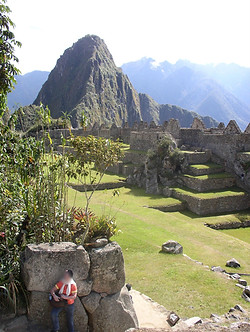
Machu Picchu
I wanted to see this place for a very long time. I think probably since I read about a hidden Incan city in the adventure series about Tomek Wilmowski. Or maybe I remembered something from an anime I watched back in the 80ties called The Cities of Gold. I cannot pinpoint exactly when my fascination started but I knew I had to see the legendary Machu Picchu.

It is situated about 80km from Cuzco 2430 meters above sea level. It is surrounded from three sides by the Urubamba river with vertical drops of 450 meters and has only two access points: through the Sun Gate (Inka Trail) and over the Inka bridge. What I didn’t know at the time is that part of the city has been restored because the nature has completely taken over and a lot of houses needed rebuilding.


The Inka Trail story is a separate one so I will focus here on the city itself. It has been re-discovered for the West by Hiram Bingham from Yale University in 1911, while he was on an expedition to find the forgotten Incan capital Vilcabamba – for some time he thought that was what he discovered. Machu Picchu was never really lost, it was just never known to the Spanish. Local population had been using the farming terraces for themselves. There are clues that there have been some Germans visiting the city in the 19th century, but since they were not part of an expedition the ruins remained ignored.
Machu Picchu is a UNESCO World Heritage Site and there are restrictions to visitor numbers as it is the most frequented tourist destination in Peru, and probably the most known in Latin America. The site is also a pristine example of Incan architecture. Not to mention ingenuity. They have been building fortresses without mortar or any binding agents. They would shape the granite stones to fit together tightly. The buildings also show many stabilising measures – the Inka were aware of earthquakes and mud slides. The terraces not only served for farming but also minimized the erosion of the peak.

There is a pyramid on the left side of the mountain. Getting on top of it is no problem at all, but to get down you have to do that on the cliff side. And it is not for the faint of heart, you’re walking down the stairs next to an almost vertical drop down to the river. Breath-taking.
Even after a three-day trek I was able to enjoy and admire the mystical city of the Inka. If you’re not up for that kind of a walk you can actually take a bus from the town of Aguas Calientes at the bottom of the valley. Just don’t forget to get your Machu Picchu stamp in your passport like I did. I blame the fever from my altitude sickness.
Seeing it photographed and reading about it is not the same as actually touching the stones and standing in awe at the precision of the craft. The granite blocks are massive and this culture hasn’t used the wheel for any practical purposes. The fact that this city has been constructed on a top of a mountain in a jungle and without any machinery is a wonder in itself.

Cuzco, Inka Trail and Machu Picchu











